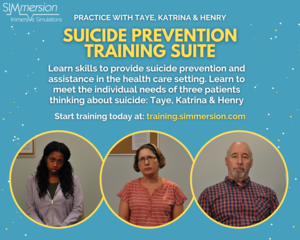
Suicide Prevention Training Suite
Scenario
Suicide is a significant public health issue that results in many deaths in the United States. Almost 83% of people who died by suicide also accessed the healthcare system within 12 months of their death. This makes clinicians a critical piece in the suicide prevention process. When a patient presents signs of suicide ideation, a suicide assessment is completed. Following the assessment, the clinician and patient can work together to decide on a course of treatment and create a safety plan. Using these tools effectively can make all the difference in keeping the patient safe and engaged in the treatment process.
The Suicide Prevention Training Suite includes access to three virtual patient training simulations:
Assessing Risk with Taye Banks: Gather information while building a collaborative relationship with Taye, a new patient who identified she is thinking about suicide on a screening questionnaire. As you get to know Taye, discuss the topics on the Columbia Suicide Severity Rating Scale to learn about her suicidal ideation, stressors, and protective factors, which change with each new play. After the session, practice documenting Taye's everyday language into clinical language appropriate for record-keeping.
Motivating to Treatment with Katrina Sanderson: Use Motivational Interviewing techniques help Katrina commit to seeing ongoing care for her suicidal ideation. Explore her feelings about therapy, her motivations and barriers around treatment, and how her life will change with and without treatment, which will change with each play. After the session, review feedback on how well you used reflections, eliciting change talk, and developed discrepancies.
Safety Planning with Henry Douglas: Collaborate with Henry to explain and create a safety plan that will work with his needs and triggers. Use the six Safety Planning Intervention (SPI; Stanley & Brown, 2012) as a guide to explore Henry's support systems, which will change with each new play. After the session, review feedback on how well you supported his autonomy, used collaborative problem solving, and built a plan tailored to keeping him safe.
While each program can be used independently of the others, they were built together, as providers are encouraged to complete an assessment, a referral, and a safety plan with everyone who expresses suicidal ideation.
Users
Healthcare,
Social Work & Students
Recommended Plays
3 - 8 minimum per simulation
Average Time
per Session
15 - 45
minutes per simulation
Each virtual patient has 2 - 4 character versions based on common levels of suicide risk, motivations and barriers toward treatment, and triggers for suicide. Taye, Katrina & Henry provide a varied training experience to prepare learners for the different needs of patients thinking of suicide.
Teaching Objectives:
- Documenting an Assessment Conversation and Identifying Next Steps
- Developing a Collaborative Relationship
- Covering Motivational Topics
- Using the Spirit of Motivational Interviewing
- Covering Safety Plan Topics
- Creating an Effective Safety Plan
Included in Training:
- A Training Guide on learning to identify and assess a patient's risk of suicide, motivating a patient to begin a course of treatment, and effectively building a safety plan.
- A Simulated Conversation with 3 varied characters to prepare learners for the different needs of patients thinking of suicide.
- Comprehensive Feedback during and after each play to help guide skill development.
This training was developed in collaboration with The Institute for Family Health and Education Development Center (EDC) with funding from The National Institutes of Health (Grant Number: #R44 MH114710). To read more about EDC's Zero Suicide Initiative visit: Zero Suicide EDC
Research
O’Brien, K., Quinlan, K., Humm, L., Cole, A., Hanita, M., Pires, W.J., Jacobs, A., & Goldstein Grumet, J. (in press). Effectiveness of a virtual patient simulation training on improving provider engagement in suicide safer care. Community Mental Health Journal. Read More
McManama O'Brien, K. H., Fuxman, S., Humm, L., Tirone, N., Jay Pires, W., Cole, A., & Goldstein Grumet, J. (2019). Suicide risk assessment training using an online virtual patient simulation. MHealth: A Journal for Research, Validation, and Discussion of Mobile Technology, Digital Health, and Medicine, Vol 5. Read More

